Ajiboye A. A.1, Ajiboye M. D.2, Agboola D. A.3, E. N. Iwuala1
1Department of Plant Science and Biotechnology, Federal University Oye Ekiti, Nigeria
2Department of Biological Sciences, Osun State University, Osogbo, Nigeria
3Department of Pure and Applied Botany, Federal University of Agriculture, Abeokuta, Nigeria
Correspondence to: Ajiboye A. A., Department of Plant Science and Biotechnology, Federal University Oye Ekiti, Nigeria.
| Email: |  |
Copyright © 2016 Scientific & Academic Publishing. All Rights Reserved.
This work is licensed under the Creative Commons Attribution International License (CC BY).
http://creativecommons.org/licenses/by/4.0/

Abstract
Studies on the effect of ecto and endomycorrhizal inoculums on seedling growth of four savanna tree seeds in Nigeria. Endomycorrhizae (Glomus mossae) and ectomycorrhizae (Saillus luteus); both were used in crude forms. The relative endomycorrhizal dependency of the seedlings were maximum in P.biglobossa seedlings by having up to 68%, 41.0% in Albizia, 35.0% in T.indica and the least was 21% in P. africana seedlings. However, T.indica seedlings had the highest ectomycorrhizal dependency with about 55.0%, while 54.0% was showed in P. africana. About 50.0% and 46.0% were shown in A. lebbeck and P. biglobossa seedlings respectively. Ectomycorrhizal inoculation greatly enhanced seedling growth and development of Prosopis africana, A. lebbeck,T. indica, P. biglobossa had the highest significant difference (p<0.05) in leaf area at treatment. Endomycorrhizal inoculation also greatly enhanced seedling growth of P. africana, A. lebbeck and T. indica, P. biglobossa had highest significant difference (P<0.05) in leaf area, leaf number, petiol length, stem girth and plant heights in the treatment. Treatment means were separated using least significant difference at 5% probability level. The results obtained in this study will foster valuable contributions in the areas of increasing the seedling growth of these savanna tree seeds through the incorporation of both ecto and endomycorrhizae into the soil. These findings will also assist to increase seedling production for agro forestry purposes in Nigeria.
Keywords:
Ectomycorrhizae, Endomycorrhizae, Seedling growth, Savanna, Tree and seed
Cite this paper: Ajiboye A. A., Ajiboye M. D., Agboola D. A., E. N. Iwuala, Effect of Ecto and Endomycorrhizae on Seedling Growth of Four Savanna Tree Seeds in Nigeria (Tamarindus Indica (L), Albezia lebbeck (benth), Prosopis africana (L) and Parkia biglobossa (Jacq.B)), International Journal of Plant Research, Vol. 6 No. 2, 2016, pp. 25-33. doi: 10.5923/j.plant.20160602.02.
1. Introduction
The diffused population of Savanna tree seeds and seedlings were observed to face regular annual bush burning, exploitation, underutilization and deforestation in order to meet man’s diverse needs for farming, lumbering, housing and industrial purposes. This had led to great modification of natural habitat of the tree crops and loss of useful genetic materials and other valuable tree species. Consequently, these savanna tree seeds are not cultivated. Therefore, the danger of extinction is imminent upon these seeds. In order to arrest this problem, foresters have made series of efforts to propagate them but they are confronted with challenges of raising the seedlings from dormant seeds. The seeds produced yearly are observed to be buried among the litters and soil while they remain quiescent for a long time. (Ajiboye, 2009).The problems facing at present is the over exploitation of bio-resources/natural resources which would not only have negative impact on the environment but also sometimes totally destroy and erode the important bio-resources which are available at local , regional and national levels (Daniel et. al, 2015).These are problems which are encountered in the regeneration of seedlings in the savanna of Nigeria vegetation, which include problems of seed collection, seed processing, seed storage, seed germination and seedling growth. The reason being that most savanna tree seeds are short-lived and exhibit dormancy (both physical and physiological) under natural conditions. This is particularly true of the tropics where ambient temperature is high. Some species have alternate heavy and light seed year, some may produce poor quality seeds. (Greater and Ajiboye, 2015).Presowing treatments of seed are intended to improve the survival or germination of seeds after sowing. The term is often shortened to “seed pretreatments” which is really a misnomer. Dry treatment of seed after it is collected could be considered as pre-sowing. The most presowing treatment is that intended to improve both amount and the speed of germination. This is especially important in species which exhibit dormancy.In improving soil nutrients, farmers have always been involved in using fertilizer as a last resort but this has not been economically feasible because the nature of the soil in the tropics do not allow for maximum utilization of nutrients from chemical sources. This is because they are characterized by the possession of low activity clay which is their parent rock materials. These soils with their fewer charged surfaces for exchanged of ions have low ion exchange capacity. Hence, fertilizer when applied are either lost through volatilization, erosion or leaching with only a little percentage being available for plant use. Since the mineral fraction cannot provide nutrient retention, nutrient availability in tropical soils is almost exclusively dependent on the amount of organic matter. Heavy tillage due to mechanization removes the organic matter layer of the soil thereby impeding nutrient retention, removing cover of soil fauna, disrupting soil structure and encouraging compaction and soil erosion. Hence high input agricultural practice that has been so successful in the Western world is not applicable to the tropical soils (Liasu, 2000). With the available technology, it is still impossible to raise savanna tree seedlings on the tropical soils without soil being degraded. Hence, research has shown that this problem could be solved through the incorporation of mycorrhizae into the savanna or tropical soils before raising savanna seeds and seedlings in balancing of nutrient absorption with nutrient replenishment (Liasu, 2000).Woody plants are such vital components of the ecosystem that have productive, protective and recreational functions (Atiku et al., 2013). They control soil erosion, stabilize regional and global climates; provide carbon sinks, and acts in pollution control. The extent to which forest trees are being exploited calls for urgent attention.Basically mycorrhizal association can be classified into two major groups (a) The Ectomycorrhiza (b) The EndomycorrhizaThe (a) refers to symbiotic association of fungal mycelia and roots in which the fungal hyphae form a compact mantle on the surface of roots and extend into the surrounding soil and inwards between cortical cells, but not into these cells. Whereas, the (b) refers to symbiotic associations between fungal mycelia and roots of certain plants, in which the fungal hyphae penetrate directly into root hairs, other epidermal cells and occasionally into cortical cells with individuals hyphae extending from the root surface outwards into the surrounding soil.Ectomycorrhizae had been reported to be in association with the forest trees and much study had been on the roles in savanna tree seedling production. (Duvick et.al, 1992)Arbuscular mycorrhizal (AM) fungi has so far been recognized as a soil microbiological resource in crop production as regards their role in increased phosphorus intake as well as other plant nutrients, biological control of root pathogen, drought resistance, and soil conservation leading generally to increased yield of economic components of plants. Some savanna trees have been known to be adapted to the infertile soil prevalent in the tropics and its low yield which has been found to improve with AM inoculation both in controlled environment as well as on the field can further enhanced by alley-cropping with leguminous plants which supply nutrient rich much from which it can draw essential minerals. (Fagboola et.al; 1998)Tamarindus indica (L) is a semi evergreen plant (Agi, 1991) it is a nature to Tropical Africa. It belongs to the family of Leguminoceae, sub family – Ceasalpinaceae. Apparently, Tamarindus indica is associated with various socio economic benefits, especially in the savannah regions where it is habitated. These benefits has made it to be known as one of the Multipurpose Tree Species (MPTS) incorporated into the ecological studies and research programmes as vindicated by the activities of such organization such as Forest Research Institute of Nigeria (FRIN), International Centre for Underutilized Crops (ICUC) and other related forestry organizations in the world. | Plate 1. Mature fruits of T. indica |
A. lebbeck is a fast growing nitrogen-fixing heavy shade tree, recommended for reforestation and firewood plantation in the tropics. This is an introduced species found growing in the wild in the guinea savanna and cultivated areas. It is a deciduous tree that is up to 30m tall, with dense shade-producing crown. The bark is smooth, light, whitish or greenish grey in colour. The leaves alternate, twice compound within 2-4 pairs of pinnate pinnae each with 4-10 pairs of leaflets. The flowers are whitish, with greenish stamen in clusters resembling a white powder puff. Pods are flat, reddish brown with several seeds often rattling in the breeze. It flowers around April-September, while fronting occurred year-round and more prominent in the dry season. The tree species is a nature to tropical Africa, Asia and Northern Australia, widely planted and naturalized throughout the tropics. This tree legume plays vital ecological roles in the savanna nutrient recycling and prevention of soil erosion (Alabi, 1993). The plant belongs to the family Leguminoceae and class Magnohopsida. The name A.lebbeck means woman’s tongue. | Plate 2. Semi-dried fruits of A. lebbeck |
P. biglobossa (Jacq. B), the seed is commonly called the African locust bean. It also belongs to the family Leguminoceae. It often grows to a height of 20m with a dense spreading crown, scaly and creviced grey-brown backslash brown. The fruit is a legume slightly indented between the seeds at maturity (Aliero, (2004). The seeds are embedded in a yellowish mealy, sweet testing edible pulp. | Plate 3. Dried fruits of P. biglobossa |
P. africana (Guil & Perr) Taub tree species is a perennial tree which belongs to the family Leguminosae. About 44 species are known to exist but only one is native to Africa. The rest occur in tropical America and Asia (Agboola, 1995). This species is small to large tree of about 4-20m tall, 1m girth with an open canopy and dropping foliage resembling T. indica. The bark is very dark and scaly, slash orange to reddish brown with white streeks, branches and twigs thornless, leaves alternate, bipinnate leaflets in 9-10 pairs, oblong lanceolate 12-30mm, shortly pubescent. At Rachis 10-15cm long. Axillary spikes calyx pubescent but petals glabrous, 10 free standing stamens, anthens with small apical glands. Flowering occurs gently before the onset of the rains (Dec.-May). Pods are red, cylindrical, hard and shinny up to 15 x 3cm compartmented with wood cell. Seeds mature in February-March containing some 10 loose rattling seeds (12mm long) per pods and 71500-8000 seed per kg. Pods do not split open when ripped. In Nigeria, they are found in fallow land on various textured soil and on lateritic soils. There are two varieties of pod, one with narrow cylindrical pods 25cm in diameter and the other with broader flattened pods 3cm in width. Pods remain on the tree long after maturity. The word “P. africana” means “African mosquito” (Ajiboye, 2009). | Plate 4. Dried fruits of P. africana |
There is need for continuous attention to solve these eminent problems in the savanna areas of Nigeria. However, multipurpose trees (MPT) and Nitrogen fixing (NFT) trees are those tree species of Nigerian natives with diversify social and economic values at various levels. These trees are becoming extinct in our local savanna as some of them are particularly difficult to propagate. Furthermore, the decrease in the population of these tree seedlings at a continuous trend and in a geometric progression are in view of continuous population growth and higher demand for social economic benefit associated with them especially as the fuel source. This generated a lot of interest in the environmental cycle. In view of the above, it deemed necessary that more research should be carried out to establish optimal methods of propagation of these tree seedlings owing to its diverse economic importance in the Nigeria.
2. Materials and Methods
Recconnaisance survey: Several trips were made on different parts of savanna zones and vegetations in Nigeria. Among these areas include: Ilorin, Ogbomosho, Kano, Sokoto, Enugu, Ebonyi, Anambra, Bauchi and Adamawa states. Fruit collectionsMatured and fresh fruits of T. indica were collected in Mubi area of Adamawa and Toro areas of Bauchi states. The fruits were found to have a sticky and gumming feel. Fresh and matured pods of A. lebbeck, P. africana and P. biglobossa were collected within the campus of University of Ilorin (8.32N and 4.34E) Ilorin of Nigeria. The pods were collected directly from their parent plant. The fruits and pods of these seeds were stored in sac or jute bag after collection and conveyed to the Biology Laboratory of the Department of Biological Sciences, Federal University of Agriculture, Abeokuta, Ogun State, Nigeria.Seed processingThe fruits of T. indica were soaked in tap water for about 24 hours. The fruits were then scrubbed manually with hands in order to extract the seeds. The fruit extracts was removed through sieving. The seeds which settled at the bottom of the water in a container, were hand-picked; the damage ones were discarded. Seeds were air-dried at room temperature for about 10hours. The good seeds were stored in tin and stored in a refrigerator. The fruits of Albizialebbeck were put in the jute bags and hit gently with a club and then hand-picked. The seeds were air-dried for about 6 hours at room temperature. The damaged seeds were removed, while the good ones were stored in a tin and stored in a refrigerator.The pods of P. biglobossa were also soaked in water for about 24hrs. They were scrubbed with sharp sand and left to settle for some minutes. Then, the seeds were washed using several tap water to raise them from yellow pulp shaft. They were also hand-picked and air-dried for 10 hours at room temperature and stored in a refrigerator.The pods of P. africana were hit on concrete slab with a granite stone of moderate size. The seeds were extracted by removing the yellow pulp, they were then hand-picked; the bad ones were discarded while the good ones were also stored in the refrigerator.Simple Floatation methodsThe seeds were poured in water in order to separate those that were viable from non-viable ones. The float seeds were considered to be non-viable while those that do not float were regarded as being viable and stored for further experiment.Mycorrhizal procurement and inoculum preparation There are two kinds of mycorrhiza that was used namely in this experiment: Endomycorrhizae (Glomus mossae) and Ectomycorrhizae (Saillus luteus); both were used in crude form. The crude inoculum of the arbuscular mycorrhizal (AM) fungus (endomycorrhiza) which is G. mossae. The multiplication was done by planting 10 seeds of maize in 25kg sterile soil in green house. About 30g of soil containing spores and hyphae of G. mossae that was collected from the department of Plant Physiology and Crop Production of the University of Agriculture was applied. The experiment was watered twice a day and monitored for 3 months. Watering was stopped at the point of cob formation to prevent nutrient diversion. Fertilization was prevented by removing the tarsels and allowed maximum carbon diversion to fungus. Subsequently, the dried maize stands were allowed to dry-up for a period of 4-5 weeks in order to promote sporulation. The maize stems were cut at the soil level and other above ground shot portions removed completely. The shoot and roots were removed along with the soil in the pot and chopped into pieces, mixed thoroughly such that the potential inoculants consisting of spores, hyphae and infected root fragment were thoroughly mixed together.However, ectomycorrhizal innoculum was collected and transported from pine-plantation site of Forestry Research Institute of Nigeria (FRIN) Jericho Ibadan (7°N and 4°E).Raising seedlings from mycorrhizal soil conditionerThe soil was sieved in 1 x 1cm wire mesh, steam sterilized and unsterilized before it was packed into nursery bags (10cm diameter 35cm deep). Savanna tree seeds (T. indica, A. lebbeck, P. biglobossa and P. africana) were planted in the soil inside the bags. Before the seeds were planted into the bags, about 30g of mycorrhiza inoculum (prepared as described above) was applied just below the soil surface of about (2.5cm depth). These set of bags were designated inoculated (i.e. TAM+, PRM+, ALM+ and PAM+) meaning inoculated T. indica, P. africana, A. lebbeck and P. biglobossa respectively while another set designated uninoculated control (M-) where TAM-, PRM-, ALM- and PAM- meaning uninoculated T. indica, P. africana, A. lebbeck and P. biglobossa respectively.Some part of the soil was not sterilized (NS) while some seedlings were water-stressed (WS) whereas some were well-watered (WW). The seedlings under the above conditions were raised for six months in the green house while growth parameters were taken at every forth-night.Mycorrhizal dependency: Estimation of leaf areaData were taken for this parameter on the four savanna tree species for 6 months. Estimate was carried out by ascertaining a correlation between leaf area and linear dimensions of the length and width of leaf of each species. The leaf of each species was placed on a 1mm2 graph paper. The leaf size was traced on the graph paper and the total area calculated based on the number of squares covered within the traced region (Ting, 1982).The formula for estimation of leaf area for each species is thus given as:
Estimation of leaf areaData were taken for this parameter on the four savanna tree species for 6 months. Estimate was carried out by ascertaining a correlation between leaf area and linear dimensions of the length and width of leaf of each species. The leaf of each species was placed on a 1mm2 graph paper. The leaf size was traced on the graph paper and the total area calculated based on the number of squares covered within the traced region (Ting, 1982).The formula for estimation of leaf area for each species is thus given as: Which is constant for each species (since each leaf determination has the same developmental pattern) (Ting 1982). Using the estimated K, leaf area is determined at all stages of growth period at intervals of two weeks for each species.Plant height, stem girth and petiole length: The plant height stem girth and petiole length were straightened to its fullest length while its measurement (cm) were taken with transparent ruler (Harold, 1957). Leave number:Only the true leaves were measured and counted as the correct number of leaves (Greater & Ajiboye 2015).Statistical analysisData were subjected to factorial of variance (ANOVA).Treatment means were separated using least significant difference at 5% probability level. Correlation between treatment means was also determined.
Which is constant for each species (since each leaf determination has the same developmental pattern) (Ting 1982). Using the estimated K, leaf area is determined at all stages of growth period at intervals of two weeks for each species.Plant height, stem girth and petiole length: The plant height stem girth and petiole length were straightened to its fullest length while its measurement (cm) were taken with transparent ruler (Harold, 1957). Leave number:Only the true leaves were measured and counted as the correct number of leaves (Greater & Ajiboye 2015).Statistical analysisData were subjected to factorial of variance (ANOVA).Treatment means were separated using least significant difference at 5% probability level. Correlation between treatment means was also determined.
3. Results
Trees of T. indica, P.africana, P.biglobosssa and A. lebbeck were found to be predominant in the savanna areas of Ilorin, Ogbomosho and Adamawa States. The savanna vegetations of these areas were described to have more grasses with scattered deciduous trees.The data of the experiment were collected and collated between October, 2007-May, 2009.SEED VIABILITY: P. africana, P. biglobossa, A. lebbeck and T. indica seeds had the percentage viability of 100%.The relative endomycorrhizal dependency of the seedlings were maximum in P.biglobossa seedlings by having up to 68%, 41.0% in Albizia, 35.0% in T. indica and the least was 21% in P. africana seedlings. However, T. indica seedlings had the highest ectomycorrhizal dependency with about 55.0%, while 54.0% was showed in Prosopis. About 50.0% and 46.0% were showed in A.lebbeck and P. biglobossa seedlings respectively (Table 1).Table 1. Percentage mycorrhizal dependency
 |
| |
|
The effect of ectomycorrhizal inoculation on the seedling growth of P. africana significantly (p<0.05) enhanced the petiole length and stem girth in all the treatments employed in this research work, followed by the leaf number. However, the leaf areas were the least significantly (p<0.05) enhanced at M-SSWW treatments (10.11c). Also, the plant height at M-NSWS showed the most least significant difference (p<0.05), (14.07e). The effect of endomycorrhizal inoculation on the seedling growth of P. africana had high significant difference (p<0.05) in stem girth, leaf area and leaf number in all the subjected treatments of the seedlings. However, the most least significant difference (p<0.05) were observed in plant height at M+SSWW (10.10d) and M+NSWS (12.55c) of the soil treatments (Table 2- 3). Table 2. Ectomycorrhiza inoculation on seedling growth of P. africana
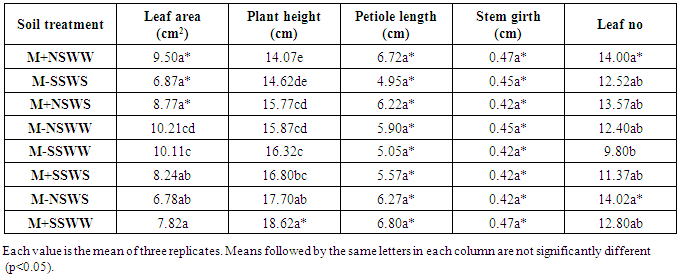 |
| |
|
Table 3. Endomycorrhizal inoculation on seedling growth of P. africana
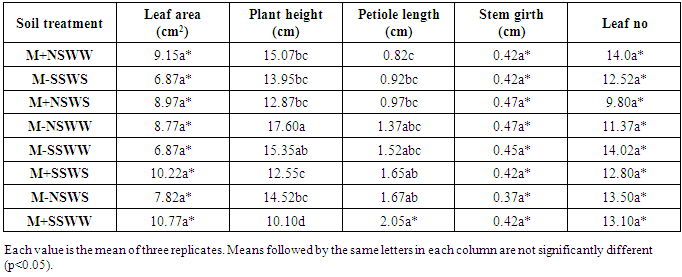 |
| |
|
The effect of the ectomycorrhizal inoculation on the seedling growth and development of P. biglobossa had the highest significant difference (p<0.05) in leaf area at treatment M+NSWW, M+SSWS, M+SSWW and M-NSWW.The effect of endomycorrhizal inoculation on the seedling growth of P. biglobossa had highest significant difference (P<0.05) in leaf area, leaf number and plant heights in the treatment M-NSWS and M-SSWS. However, the petiole length at treatment M-SSWW were least significant (p<0.05) (1.25d) (Table 4-5). Table 4. Ectomycorrhizal inoculation on seedling growth of P. biglobossa
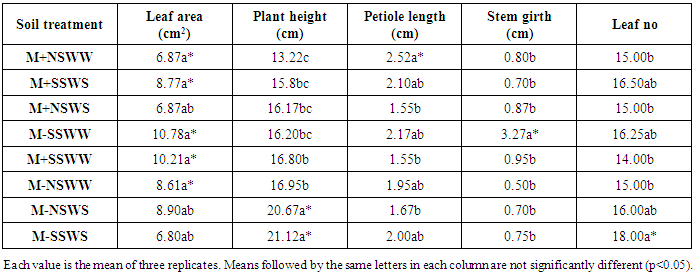 |
| |
|
Table 5. Endomycorrhizal inoculation on seedling growth of P. biglobossa
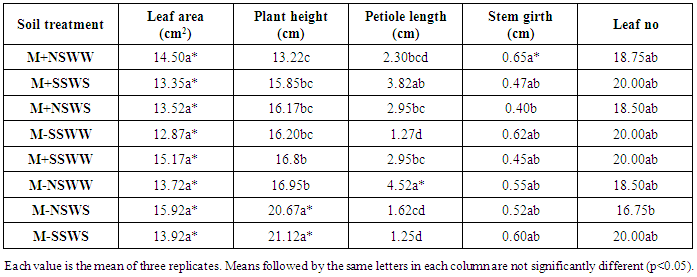 |
| |
|
The response of the seedling growthof A. lebbeck to ectomycorrhizal inoculation were maximum in significant difference (p<0.05) in leaf number in all the treatment involved while M-SSWS showed least significant difference (p<0.05).The response of A. lebbeck seedlings to endomycorrhizal inoculation were partially significant (p<0.05), especially in plant height and stem girth. Whereas, the leaf number and leaf area showed least significant difference (p<0.05). (Table 6-7).Table 6. Ectomycorrhizal inoculation on seedling growth of A. lebbeck
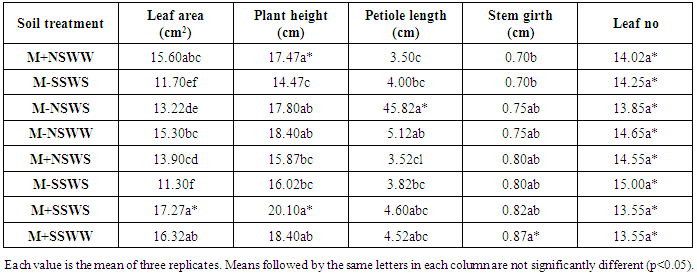 |
| |
|
Table 7. Endomycorrhizal inoculation on seedling growth of A. lebbeck
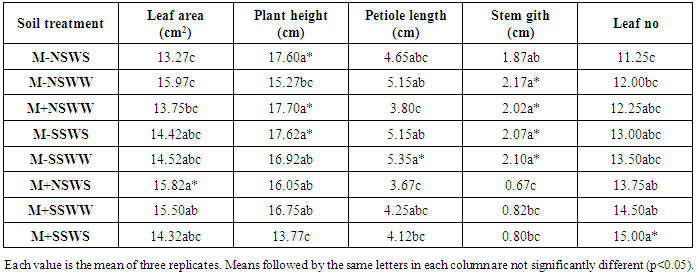 |
| |
|
The responsiveness of the T. indica seedlings to the ectomycorrhizal inoculation treatments were highest in significant difference (p<0.05) in plant height of the seedlings. While the leaf number, stem girth, petiole length and leaf area were partially significant (p<0.05). However, the treatment like M+NSWW and M-NSWW showed the least significant difference.The response of T. indica seedlings to the endomycorrhizal inoculation were also partially significant (p<0.05) in stem girth, petiole length, plant heights and the leaf area of the plant seedlings. However, the level of significant difference (p<0.05) in the leaf areas were more than other growth parameters of the seedlings. Treatments that is M+SSWW and M+SSWS showed most least significant difference (p<0.05). (Table 8- 9). Table 8. Ectomycorrhizal inoculation on seedling growth of T. indica
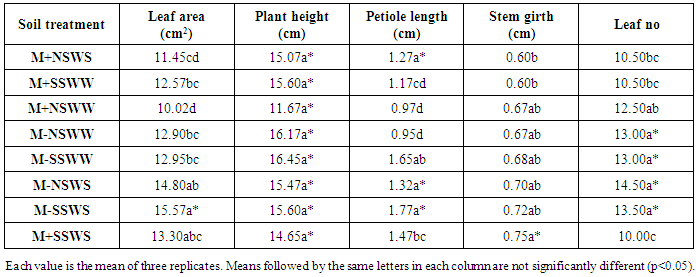 |
| |
|
Table 9. Endomycorrhizal inoculation on seedling growth of T. indica
 |
| |
|
4. Discussion
Mycorrhizae are symbiotic association between plant roots and certain soil fungi [9]. The word “Myco” meaning fungus and “Rhiza” meaning root apply describes this mutualistic association between plant roots and soil borne fungi in which the plant supplies the carbon requirement of the fungus and the fungus assist the plant in the procurement of water and mineral salts in return. Mycorrhizal fungi are so peculiarly specialized that they cause little or no damage to their host. Thus a balance is established where both fungi and plant derive mutual benefit from the association (Jackson, 1994). Frank, F. R, (1995) was the first scientist to describe “Mykorrhiza” in trees of temperate forest and pines in Germany. The relative endomycorrhizal dependency of the seedlings were maximum in P.biglobossa seedlings by having up to 68%, 41.0% in Albizia, 35.0% in T.indica and the least was 21% in P. africana seedlings. However, T. indica seedlings had the highest ectomycorrhizal dependency with about 55.0%, while 54.0% was showed in P africana. About 50.0% and 46.0% were showed in A.lebbeck and P.biglobossa. These results ware compared to the findings of (Greater and Ajiboye, 2015).The effect of ectomycorrhizal inoculation on the seedling growth of P. africana significantly (p<0.05) enhanced the petiole length and stem girth in all the treatments employed in this research work, followed by the leaf number. However, the leaf areas were the least significantly (p<0.05) enhanced at M-SSWW treatments (10.11c). Also, the plant height at M-NSWS showed the most least significant difference (p<0.05) (14.07e). The effect of endomycorrhizal inoculation on the seedling growth of P. africana had high significant difference (p<0.05) in stem girth, leaf area and leaf number in all the subjected treatments of the seedlings.The effect of the ectomycorrhizal inoculation on the seedling growth and development of P. biglobossa had the highest significant difference (p<0.05) in leaf area at treatment M+NSWW, M+SSWS, M+SSWW and M-NSWW. This findings compared with the research of [3]. Ectomycorrhizae are commonly associated with certain trees while endomycorrhizae are associated with both trees and annual crops. Recent review of works on mycorrhizal symbiosis by Srivastava et al. (1996) recognizes seven types of mycorrhizae based on the extent of root penetration production of external mantle or shealth and inter and intra cellular structures. The effect of endomycorrhizal inoculation on the seedling growth of P.biglobossa had highest significant difference (P<0.05) in leaf area, leaf number and plant heights in the treatment M-NSWS and M-SSWS. However, the petiole length at treatment M-SSWW were least significant (p<0.05).The response of the seedling growth of A. lebbeck to ectomycorrhizal inoculation were maximum in significant difference (p<0.05) in leaf number in all the treatment involved while M-SSWS showed least significant difference (p<0.05).The response of A. lebbeck seedlings to endomycorrhizal inoculation were partially significant (p<0.05), especially in plant height and stem girth. Whereas, the leaf number and leaf area showed least significant difference (p<0.05). (Table 6-7).The responsiveness of the T. indica seedlings to the ectomycorrhizal inoculation treatments were highest in significant difference (p<0.05) in plant height of the seedlings. While the leaf number, stem girth, petiole length and leaf area were partially significant (p<0.05). However, the treatment like M+NSWW and M-NSWW showed the least significant difference.The response of T. indica seedlings to the endomycorrhizal inoculation were also partially significant (p<0.05) in stem girth, petiole length, plant heights and the leaf area of the plant seedlings. However, the level of significant difference (p<0.05) in the leaf areas were more than other growth parameters of the seedlings. Treatments that is M+SSWW and M+SSWS showed most least significant difference (p<0.05). This showed that the mycorrhizal inoculation relatively improved the seedling growth of the savanna tree seedlings. Mycorrhizal symbiosis are of common occurrence in the plant kingdom and are reported from bryophytes, ptendophytes, some gymmosperms and most angiosperms (Srivastava, et.al; 1996) and it represents one of the most ancient associations having a long evolutionary history Fritter, 1991).
5. Conclusions and Recommendations
The both ecto and endomycorrhizal have established to increase the seedling productivity of these endangered savanna tree seeds species in Nigeria. It is therefore recommended as a biofertilizer booster for the gradually extinct savanna seedlings. It is also recommended that the government of Nigeria should fund agroforestry projects involving these valuable tree seeds and should resolve to use mycorrhizal organisms rather than the inorganic fertilizers that could be inimical to our immediate environment. Experts in this area should be employed in the agro forestry sections to execute this project in order to sustain and retain the core values of these tree seed species.
ACKNOWLEDGEMENTS
The authors are grateful for the technical assistance received from the technical staff of the Department of pure and applied Botany, Federal university of Agriculture, Abeokuta, Ogun state, and Department of Plant science and Biotechnology, Federal university, Oye Ekiti. Ekiti state.
References
| [1] | Agboola, D. A. (1995): Studies on dormancy and germination of seeds of Prosopis africana. Nigerian Journal of Botany 8:45-56. |
| [2] | Agi, J (1991): Ecology of the Tamarind. A project report for B.Sc of Bayero University, Kano. Nigeria. |
| [3] | Ajiboye A.A (2009): Seed germination and seedling physiology of four multipurpose savanna tree seeds in Nigeria Ph.D thesis, Department of Biological sciences, Federal university of Agriculture Abeokuta, Ogun state Nigeria. 352pp. |
| [4] | Atiku M., Bello A.G. and Alao J.S. 2013. Study of Some Tree Characteristics at Tangaza North Forest Reserve in Sokoto State Nigeria. Agricultural Science Research Journal 3(10): 318- 323. |
| [5] | Alabi, D. A. (1993): Parkiabiglobossa, an endangered species. Proceedings of the seminar on lost crops in Nigeria, University of Agriculture, Abeokuta, Nigeria. Pp 265-283. |
| [6] | Aliero, B. L (2004): Effects of sulphric acid, mechanical scarification and wet heat treatments on germination of seed of African Locust bean tree, Parkia biglobossa; African Journal of Biotechnology 3(3) 179-181. |
| [7] | Atayese, M. O. (1994): Influence of mycorrhizal inoculation and pruning regime on productivity of cassava and woody legumes in alley-cropping system. A Ph.D Thesis of Department of Botany and Microbiology of the University of Ibadan, Ibadan, Nigeria. |
| [8] | Bello A.G. 2005. The Role of Biodiversity on Sustainable Agriculture. A Paper Presented to a 2 Days Training Workshop on Rural Resource Utilization and Sustainable Agriculture. 7th and 8th April Unpublished. |
| [9] | Daniel A. Zhigilai, Fatima B.J, Sawas, Suleiman D. Abdul, Halima M. Abba and Murna Tela (2015): Diversity and Phytogeographic investigations into woody plants of Tangaza Forest reserve, Sokoto, state Nigeria. International Journal of Plantresearch 5(4):73-79. |
| [10] | Duvick D. N. G. H, Heichel and W.W. Mc. Fee (1992): Forewood. In G.S Bethlenfalvary and R.G Linderman (Eds). Mycorrhizae in Sustainable Agriculture. American Society of Agronomy. A. S A. Special publication No 54. |
| [11] | Fagboola, O. Osonubi, O and K. Mulongoy (1998): Contribution of arbuscularmycorrhizal (VAM) fungi and hedgerow trees to yield and nutrient uptake of cassava in an alley cropping system. Journal of Agriculturalscience 131:79-85. |
| [12] | Frank, F. R, (1995): (Java script: Popup (citart 1; b15; 109.046/j. 1365-2621.2002 002xjbj 13652621 20020055xj”>) online article, Retrieval date:11/06/06. |
| [13] | Fritter A. H; (1991): Cost and Benefits of mycorrhizal implication for functioning under Natural conditions. Experimental 47:350-355. |
| [14] | Greater K. Oyejobi and Abiodun A. Ajiboye (2015): Efficacy of mycorrhizae inoculations on seed germination and plant growth of Bambara groundnut Vignasubterranea (TVsu 283). African Journal of Agricultural Research 10(9)1022-1030. http://www.academic journals.org/AJAR. |
| [15] | Harold F.H (1957): The measurement and values of Plant height in the study of herbaceous vegetable Ecology 38:313-320, http//dx.doi 10.2307/1931691. |
| [16] | Jackson M. B. (1994): Root-to-shoot communication in flooded plants. Involvement of Abscisis acid, ethylene and 1- ammocy. Clopropane-1-carbocylic acid. Agron. J. 86 (5): 775-781. |
| [17] | Liasu, M. O (2000): The effect of mycorrhizal Inoculation on productivity of cassava and hedgerow trees in continuing alley-cropping system in Ajibode Village, Nigeria. A P.hD thesis of the department of Botany and Microbiology of the University of Ibadan, Ibadan, Nigeria. |
| [18] | Okon, I. E (1996): Influenced mycorrhizal and alley- cropping with legumeons hedgerow tree on the production of cassava and maize on an alfisol. Ph D Thesis of the Department of Botany and microbiology, University of Ibadan, Ibadan Nigeria. |
| [19] | Osonubi, O, M, O. Atayese and K. Mulongoy (1995): The effect of Vesiculararbscula mycorrhiza inoculation on nutrient uptake and yield of alley cropped cassava in a degraded alfisol of South Westhern Nigeria. Bio Fert Soils 20:70-76. |
| [20] | Srivastava, D. R, Kapoor, S. K, Srivastava and K. G Mukerji (1996): Versiculararbuscular mycorrhiza. In: edMukerji, K. G. Concepts in mycorrhizal research Khover Academic Publishers Netherlands pp 1-40. |
| [21] | Ting, I. P, (1982): Plant physiology. Phillipiines Addison – Wesley publishing company. |







 Estimation of leaf areaData were taken for this parameter on the four savanna tree species for 6 months. Estimate was carried out by ascertaining a correlation between leaf area and linear dimensions of the length and width of leaf of each species. The leaf of each species was placed on a 1mm2 graph paper. The leaf size was traced on the graph paper and the total area calculated based on the number of squares covered within the traced region (Ting, 1982).The formula for estimation of leaf area for each species is thus given as:
Estimation of leaf areaData were taken for this parameter on the four savanna tree species for 6 months. Estimate was carried out by ascertaining a correlation between leaf area and linear dimensions of the length and width of leaf of each species. The leaf of each species was placed on a 1mm2 graph paper. The leaf size was traced on the graph paper and the total area calculated based on the number of squares covered within the traced region (Ting, 1982).The formula for estimation of leaf area for each species is thus given as: Which is constant for each species (since each leaf determination has the same developmental pattern) (Ting 1982). Using the estimated K, leaf area is determined at all stages of growth period at intervals of two weeks for each species.Plant height, stem girth and petiole length: The plant height stem girth and petiole length were straightened to its fullest length while its measurement (cm) were taken with transparent ruler (Harold, 1957). Leave number:Only the true leaves were measured and counted as the correct number of leaves (Greater & Ajiboye 2015).Statistical analysisData were subjected to factorial of variance (ANOVA).Treatment means were separated using least significant difference at 5% probability level. Correlation between treatment means was also determined.
Which is constant for each species (since each leaf determination has the same developmental pattern) (Ting 1982). Using the estimated K, leaf area is determined at all stages of growth period at intervals of two weeks for each species.Plant height, stem girth and petiole length: The plant height stem girth and petiole length were straightened to its fullest length while its measurement (cm) were taken with transparent ruler (Harold, 1957). Leave number:Only the true leaves were measured and counted as the correct number of leaves (Greater & Ajiboye 2015).Statistical analysisData were subjected to factorial of variance (ANOVA).Treatment means were separated using least significant difference at 5% probability level. Correlation between treatment means was also determined. Abstract
Abstract Reference
Reference Full-Text PDF
Full-Text PDF Full-text HTML
Full-text HTML







